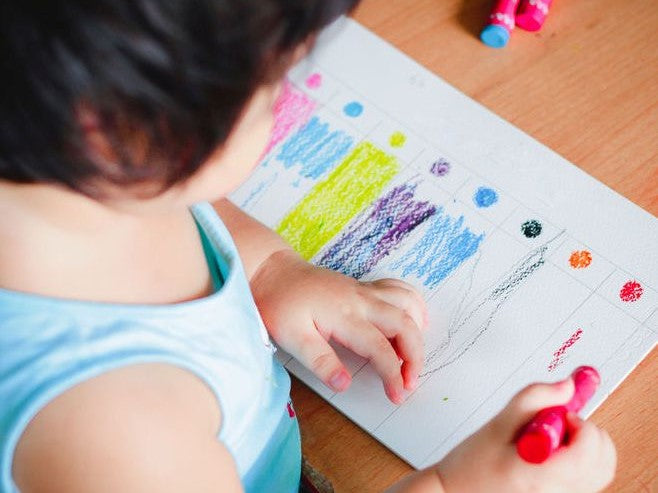
Happy November, My Friend!
Coloring? Yes, coloring!
Remember coloring when you were a kid? Crayons even smell like childhood to me. And although coloring has taken a backseat to touch screen devices and computers, kids still love to color.
I say, bring out the coloring activities and crayons whenever you can.
Of course, coloring in speech and language therapy is not to just an art project that concludes with a pretty picture. Although that’s important, the emphasis of coloring during therapy is more about the process than the end result.
Like all therapy tasks, “coloring” requires us to personalize and amplify the activity to build and support the child’s needs.
The following shares a few set-up procedures to do prior to therapy, several therapy activities, and additional developmental benefits.
The Set-Up
Read, The Day the Crayons Quit, by Drew Daywalt: You may be familiar with this book already; it’s a bestseller and totally fun. It’s a little wordy for some of our language kids, but's got a great message. Kids will be inspired to color after reading this book about crayons. Keep in mind, it is part of the “Crayons” series, e.g.The Day the Crayons Came Home, and there’s books about colors, and numbers, and saving the rainbow. Very cute.
Go to Storylineonline.net (one of my favorite sites) and watch the video of the book, Turkey Trouble by Wendi Wilvano, and then discuss it: If you’ve never been to this site or used it with your kids, I highly recommend you do so. Love it! This book is absolutely cute and great for young children. It’s sequential, repetitive, and has a fun premise.
Use crayons (as opposed to markers): Children can vary their hand-pressure to make light or dark markings when using crayons. To a degree, this can also be done with colored pencils, but can’t be accomplished with a marker. Markers don’t provide the resistive feedback that a crayon does.
Have a crayon sharpener handy: Sharper crayons help with fine movement control and dexterity. Most kids like their crayons relatively sharp, but there is a benefit to coloring with the dull ones. More on that below.
Show a completed example—or not: Whether you choose to show the children a finished example (that you or another child did) prior to beginning the task, or not, is up to you and the kids you are working with. Some kids will be inspired and use your example as something to aspire to, others will interpret the example as non-reachable and feel overwhelmed before they start. Use your judgement.
Speech & Language Activities
So how can you incorporate speech and language tasks into a coloring activity? Here are a few therapy ideas and benefits that your kids will enjoy.
Organize and plan; think-alouds and question formation; sequencing and first-middle-last: Similar to giving a child a piece of paper and pre-thinking what to write, thinking and organizing processes can be incorporated prior and during a simple coloring activity. Use either a blank sheet of paper or a black-line design. Prior to diving in, ask them to think. Think aboutwhat andhow they are going to color, i.e., what colors they’ll use and which items they’ll color first then second. What’s their approach? Do a think-aloud example for them, then ask them to tell what they’re thinking, as well.Think-alouds always involve asking ourselves questions. Then, when they’ve completed their coloring activity, ask them to recall and tell which item/part they did first then next, etc. Or, you could take a first-middle-last approach.
Color Thanksgiving Turkeys: No doubt you have turkeys in your materials arsenal. If you don’t, or you want a few more options,click here for a PDFof five line-drawing turkeys that need to colored. Also, for future use, here’s the website where I got them,www.coloring.ws (from DLTK). The website is ALL about coloring and offers tons of free things to color within a myriad of categories.
The first turkey in thePDF of five turkeys, is the most simplistic of all the drawings and can be used to color and write a message to family members as a Thanksgiving gift. Ask the child to write in each turkey feather one thing they are thankful for. There are several ways to shape this into a thinking-talking-asking interactive activity. Here are a few suggestions to get you started.
Discuss the synonyms of “thankful.” Then, say something to the effect, “I want you to think of one thing you are thankful for, but don’t say it out loud, keep it in your mind.” If they can write, have them write it down and hide it. Then, ask the others to generate general-to-specific questions directed to that child to zero-in on what he/she is thankful for.
Ask each child to choose one or two thankful-things and talk about why they choose that. Encourage others in the group to ask that person questions. Urge them to be interested in what the person is saying and to formulate questions.It’s so very helpful to do question formation within context.
Chances are each thankful-thing written in the feathers will be a noun. Use those words to construct verbal and written sentences. Add adjectives and verbs, and identify them as such, etc.
Coloring, listening, thinking, and speaking: Read a narrative (story, poem, article, reader’s theater script) or watch a video (Storylineonline.net, or there are many people that read books and post them on YouTube, etc.). Prior to reading the narrative, explain that afterwards, you all will discuss it and have the opportunity to ask questions. Encourage them to ask questions, too. So, after reading or watching, give them the coloring task (like the black-lined turkey if you watchedTurkey Trouble). Discuss and ask questionswhile they color. Encourage them to listen, color, think, and occasionally talk, simultaneously. This is typically what is required in the classroom. It’s interesting how some children actually do better (apparently the coloring helps them focus), and others, it conflicts.
For young ones, use color crayons to teach and reinforce colors/matching and concepts: While coloring, practice color identification (name, compare, contrast, and match), as well as outline and/or draw shapes, and distinguish between light and dark, inside and outside the lines, top, middle, and bottom, center, part to whole, etc.
Use in articulation and language discrete games: Spin, or roll the die, or pick a number out of a hat, etc. The number they get not only specifies the number of speech and or language targets they say, it also indicates the number of areas they color. Whoever colors the entire picture first, wins the game.
Use in barrier games: Barrier games are pretty popular among kids and SLPs. Everyone has the same line-drawing to color behind the barrier. One person gives the directions the others follow. The step-by-step instructions usually involve descriptive words with lots of prepositions. It’s all about listening, remembering, and following directions. In my barrier games, I encourage the kids to ask the instruction-giver qualifying questions, like, “Do you mean color the feather on the left side next to the red feather?”
Provide a timeline guide: For children who either impulsively rush through the coloring activity, or for those who are excessively slow, or for the kids who quit the task due to poor endurance and stamina--try using a timer. My favorite is the TimeTimer. (I’ve used them for years. They’ve expanded their product line and they’re great. Go toTimeTimer.com; click on Products, then All Timers. They have a new one that inserts into a whiteboard, love it).
Determine automaticity of speech sounds and/or language targets: This is a great way to determine if carryover has seated, or not. Engage the child in conversation while doing a simultaneous activity, such as coloring. Obviously, the child is not totally focused on his speech or language and if his/her targets are correct, chances are good that generalization has taken place. (I’ve also done this where the child walks backwards and talks. This works pretty well, too.)
Additional Benefits
It’s been said that the act of coloring opens the frontal lobe of the brain and helps focus the mind.
According to Dr. Fuster (Fuster, 2002, page 378; semi-paraphrased), the general function of the prefrontal cortex is the temporal organization of actions toward temporal biological or cognitive goals…whether in the form of behavior, speech, or reasoning. It is the novelty and complexity of those actions that qualify the prefrontal cortex as the so-called “organ of creativity.”
Coloring certainly exercises and enlists creativity, but there are several other developmental benefits, as well.
-
Individual accomplishment: How a child approaches the coloring task and the ultimate result is individually theirs, i.e., a visual, tangible consequence of somethingthey did. No matter how it looks like, the final accomplishment is theirs. Lest they compare their results to others, it’s a perfect time to emphasize individuality.
-
Ease up: Some children are just hard on themselves as to what they do and judgmental of their creation. Coloring is an excellent opportunity to address children with perfectionist tendencies.
-
Fine Motor -- Smaller coloring areas require more controlled movements and dexterity: For difficulties in this area, consider adding boundaries to coloring areas, with darkened and thicker lines or raised boundaries like using Wikki Stix around the coloring area. (Wikki Stix are colorful, they bend and are easy to manipulate, and stick to the page.)
-
Fine Motor -- Fine motor skills and tripod pencil grasp: Coloring helps to strengthen the small, intrinsic muscles in their hand. Coloring with broken crayons requires more work and is a greater strengthening task for kids who need to work on their tripod grasp.
-
Fine Motor -- Bilateral Coordination: Coloring requires the use of both hands in a coordinated manner. The child must learn to angle and hold the paper as he/she colors. This ability carries over to writing tasks, as well, and makes coloring a helpful activity for kids who switch hands in activities.
-
Fine Motor -- Stabilization and Spatial Awareness: Coloring and writing requires body-arm-hand stabilization and position awareness. In addition, on the page, coloring requires line awareness, margin awareness, and how to color within a given space.
-
Fine Motor -- Hand-Eye Coordination: When coloring , kids must coordinate their physical movements with what they see. Coloring helps to learn the coordination of the visual input with the physical movements of the hands.
Coloring inspires personal creativity and helps build self-confidence in tackling other hand-eye tasks like handwriting and free-drawing. But mostly, coloring is fun. No doubt, you and your kids will come up with additional great ideas—so, have fun!
In light of the season, I want to let you know I’m thankful for YOU!
Thank you, too, for all you do with your therapy-kids,
Char
P.S. If you made it all the way to the end of last weeks’ Therapy Matters, I mentioned that resting postures (part 1 of 3) would be this week’s topic. Well, it’s not! I decided to squeeze in something a little more apropos for the coming holidays. Next, week, resting posture therapy. For sure.
P.P.S. A suggestion…. Last weeks article was a prep to discussing resting posture therapy. If you have a chance you might want to review last weeks post (#35: Speech and Mouth Breathing: What We Need to Know).
Resource
Fuster, JM. Frontal lobe and cognitive development. Journal of Neurocytology, 31, 373-385 (2002).
Leave a comment (all fields required)
Comments will be approved before showing up.

![#71 Telepractice Tips 'n Info (Part 4) [Is my child working or just playing games?]](http://speechdynamics.com/cdn/shop/articles/Game_Pieces_and_Hand_7_x_3_2048x.jpg?v=1605804364)